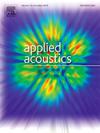Acoustic performance in accommodation buildings: From LEED and WELL application to the development of an acoustic classification method and a priority index
IF 3.4
2区 物理与天体物理
Q1 ACOUSTICS
引用次数: 0
Abstract
Lately, prioritizing the comfort of building occupants has become a key focus in the construction sector. At international level, this is evident with the prominence gained by rating sytems such as LEED and WELL, through which a third party certifies buildings with respect to well-being and impact on the environment and human health. At National level, instead, regulations such as Minimum Environmental Criteria (DM 23/06/2022), provide general indications, aimed at a rationalizing consumptions and promoting sustainable design and operations practices, which directly affect the comfort of inhabitants and workers.
In the framework of the various criteria considered, acoustic performance is increasing its relevance. The standards differ from each other and do not always require the same levels of quality and performance. Therefore, it is necessary to evaluate and prioritize the superior quality ones on a case-by-case basis. Moreover, not all uses have uniquely identified limits. For example, accommodation facilities lack specific guidelines, which leads to the adoption of personal protocols by owners and designers, resulting in the inability to make comparisons and classifications at national and international levels.
In this study, the spaces of a hospitality facility, housed in a historic building and undergoing refurbishment, were qualified following LEED and WELL certifications, chosen as a target for their supranational value. In field measurements and numerical simulations were executed on the building to determine sound transmission and reverberation time pre and post renovation, and to assess how retrofit interventions impact the protocols’ parameters and credits. The procedure highlighted the areas of the building which need acoustic improvements, as well as identified actions that would yield the greatest impact for the purpose of earning the certifications. As a useful tool for similar applications, a method for the acoustic classification of rooms and buildings by means of a single index (global Acoustic Performance Level) was developed, assuming as acoustic quality descriptors the predictive and in-situ insulation of partitions and the reverberation time. Moreover a Priority Index is proposed to find areas or elements for which interventions take precedence, set to the minimum assumed for the classification procedure and based on use, in terms of acoustic criticality and occupancy, and geometrical features of a space.
住宿建筑的声学性能:从LEED和WELL应用到声学分类方法和优先指标的发展
最近,优先考虑建筑物居住者的舒适度已成为建筑行业的一个关键焦点。在国际层面上,LEED和WELL等评级系统所获得的突出地位证明了这一点,通过这些评级系统,第三方可以对建筑的幸福感以及对环境和人类健康的影响进行认证。相反,在国家层面,最低环境标准(DM 23/06/2022)等法规提供了一般指示,旨在使消费合理化,促进可持续的设计和运营实践,这直接影响到居民和工人的舒适度。在考虑的各种标准的框架中,声学性能正在增加其相关性。这些标准彼此不同,并不总是要求相同的质量和性能水平。因此,有必要根据具体情况对优质产品进行评估和排序。此外,并非所有用途都有唯一确定的限制。例如,住宿设施缺乏具体的准则,导致业主和设计师采用个人协议,导致无法在国家和国际一级进行比较和分类。在这项研究中,酒店设施的空间位于一座历史建筑中,正在进行翻新,符合LEED和WELL认证,被选为其超国家价值的目标。现场测量和数值模拟在建筑上进行,以确定改造前后的声音传播和混响时间,并评估改造干预措施如何影响协议的参数和信用。该程序突出了建筑物中需要声学改进的区域,并确定了为获得认证而产生最大影响的行动。作为类似应用的有用工具,我们开发了一种通过单一指标(整体声学性能水平)对房间和建筑物进行声学分类的方法,假设隔墙的预测和原位隔热以及混响时间作为声学质量描述符。此外,还提出了一个优先指数,以寻找优先干预的区域或元素,并根据使用情况、声学临界性和占用率以及空间的几何特征,将其设置为分类过程中假设的最小值。
本文章由计算机程序翻译,如有差异,请以英文原文为准。
求助全文
约1分钟内获得全文
求助全文
来源期刊

Applied Acoustics
物理-声学
CiteScore
7.40
自引率
11.80%
发文量
618
审稿时长
7.5 months
期刊介绍:
Since its launch in 1968, Applied Acoustics has been publishing high quality research papers providing state-of-the-art coverage of research findings for engineers and scientists involved in applications of acoustics in the widest sense.
Applied Acoustics looks not only at recent developments in the understanding of acoustics but also at ways of exploiting that understanding. The Journal aims to encourage the exchange of practical experience through publication and in so doing creates a fund of technological information that can be used for solving related problems. The presentation of information in graphical or tabular form is especially encouraged. If a report of a mathematical development is a necessary part of a paper it is important to ensure that it is there only as an integral part of a practical solution to a problem and is supported by data. Applied Acoustics encourages the exchange of practical experience in the following ways: • Complete Papers • Short Technical Notes • Review Articles; and thereby provides a wealth of technological information that can be used to solve related problems.
Manuscripts that address all fields of applications of acoustics ranging from medicine and NDT to the environment and buildings are welcome.
 求助内容:
求助内容: 应助结果提醒方式:
应助结果提醒方式:


